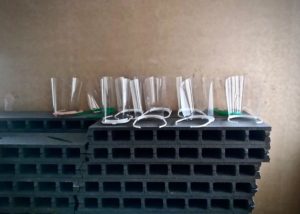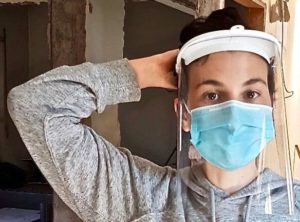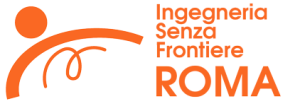Stampa 3d di visiere per gli ospedali
Le seguenti attività sono state fatte in collaborazione con il progetto protesi 3d per il Rojava:
 E’ vero, ci abbiamo messo del tempo a entrare anche noi fra i makers solidali che da qualche settimana si sono messi a produrre valvole, mascherine ed altre componenti di attrezzature; in cambio, quando uscirà questo post non sarà per un annuncio su una cosa da fare, ma per dire cosa abbiamo già fatto e probabilmente faremo nel futuro.
E’ vero, ci abbiamo messo del tempo a entrare anche noi fra i makers solidali che da qualche settimana si sono messi a produrre valvole, mascherine ed altre componenti di attrezzature; in cambio, quando uscirà questo post non sarà per un annuncio su una cosa da fare, ma per dire cosa abbiamo già fatto e probabilmente faremo nel futuro.
Diciamo pure che la nostra “missione” sarebbe di continuare a produrre e sperimentare protesi per il Rojava, ma insomma il laboratorio è infrequentabile ed inevitabilmente durante le periodiche riunioni via web abbiamo cominciato a discutere di quello che altri makers cominciavano a fare…. Eppure a tutti i modelli di mascherina 3D che venivano fuori mancava sempre qualcosa di non facile reperibilità (come il TNT o Tessuto Non Tessuto con capacità filtrante) o erano difficili da montare. E poi come proporsi per far arrivare le cose prodotte alle situazioni che ne avevano una reale necessità?
Le cose hanno preso una accelerata dopo che il Dipartimento di ingegneria dell’univeità di ROMA 3 ha fatto una call pubblica chiedendo a chi a Roma ha una stampante 3D di produrre componenti di respiratori. I ragazzi e le ragazze di ISF hanno aderito, a nome del Gruppo Protesi 3D, a questa call e…… da una settimana stiamo aspettando il via per produrre Charlotte e Dave. Le due valvole necessarie per adattare una maschera da snorkeling ai respiratori, e stiamo ancora aspettando.
Nel frattempo un altro componente del gruppo, diciamolo pure un grande smanettone, entra in contatto con un gruppo di makers nel Lazio che coordina la produzione di vari oggetti per ospedali e strutture sanitarie.
La stampante viene trasferita in una nuova postazione, di più semplice accesso in questo periodo di spostamenti limitati (e ringraziamo anche per questo l’associazione CoTa, che si mette in prima linea per le certificazioni e per tutelare i movimenti dei volontari nel tragitto casa-stampante-casa).
Una prima richiesta a cui rispondiamo è la produzione di mascherine per l’Ospedale Gemelli di Roma. In totale 70 mascherine suddivise fra diversi makers dell’area romana e dintorni.
Ci inviano l’stl (il modello da stampare) e i parametri da inserire nel software opensource che comanda la stampante.
Come al solito le prime stampe non vengono benissimo perché gli strati stampati non sono compatti. Non succede solo a noi e si affinano i parametri. Nel frattempo scopriamo che il vetro che copre il letto della stampante non è piatto al 100%, ha un dislivello nella parte centrale di qualche millimetro, ma basta questo per impedire una perfetta adesione al piatto dei primi strati stampati.
Come si fa visto che le vetrerie sono chiuse? Abbiamo fortuna, parecchia: non solo un vetraio del quartiere (una bottega in via Dulceri 86) apre la vetreria per noi e taglia il vetro dello spessore corretto, ma spiegato a cosa ci serve ce lo regala. Grande vetraio, grazie!
Riprendiamo le stampe e finalmente le prove vengono bene. Ne mettiamo in stampa 3 alla volta per una durata di stampa di 6 ore. Ne facciamo di verdi e di bianco e riusciamo anche a trovare il PVC da 0,25 millimetri per fare la copertura frontale.
Va tut to bene, forse troppo e succede l’imponderabile: un signore che dice di essere un ispettore di polizia ci vede entrare nella cantina dello stabile in cui si trova la stampante e chiede “se abbiamo le autorizzazioni”. Alla risposta che abbiamo la richiesta di un ospedale, l’incarico di un’associazione e le autocertificazioni, passa ad altro e dice che non possiamo stampare nella cantina…. Naturalmente rifiuta di esibire un qualunque tesserino di riconoscimento, dopo che gli diciamo che avremmo scritto al “suo” commissario” per denunciare questo comportamento. Coinvolge altri condomini e alla fine, visto che dobbiamo trovare una soluzione rapida per andare avanti, trasferiamo la stampante qualche piano più sopra.
to bene, forse troppo e succede l’imponderabile: un signore che dice di essere un ispettore di polizia ci vede entrare nella cantina dello stabile in cui si trova la stampante e chiede “se abbiamo le autorizzazioni”. Alla risposta che abbiamo la richiesta di un ospedale, l’incarico di un’associazione e le autocertificazioni, passa ad altro e dice che non possiamo stampare nella cantina…. Naturalmente rifiuta di esibire un qualunque tesserino di riconoscimento, dopo che gli diciamo che avremmo scritto al “suo” commissario” per denunciare questo comportamento. Coinvolge altri condomini e alla fine, visto che dobbiamo trovare una soluzione rapida per andare avanti, trasferiamo la stampante qualche piano più sopra.
Finiamo le stampe e in totale abbiamo pronte 10 strutture a cui applicare la copertura frontale. L’ultimo passaggio sarà la sanificazione delle mascherine (con uso di una soluzione con acqua e candeggina) e il loro confezionamento in busta per garantirne l’integrità.
E’ la prima operazione che si conclude e condividiamo un nuovo obiettivo con il gruppo dei makers, si tratta della stampa di visiere protettive per l’ospedale di Tor Vergata.
Nel frattempo nessuna notizia e nessuna richiesta arriva dal Dipartimento di Ingegneria dell’Università di Roma Tre. Charlotte e Dave aspetteranno.
OUR 3D PRINTED VISORS: SOLIDARITY AND PARTICIPATORY TECHNOLOGY
It is true, it took us some time to join the solidarity network of makers who have been producing valves, masks and other equipment components for a few weeks; in return, when this post is not an announcement about our plans, but to report on what we have already done and intend to do in the future.
Our “mission” is to continue to produce and test prostheses for Rojava, but the laboratory is not currently accessible. Because of this, during our periodic online meetings we began to discuss what other makers have started doing. All the 3D mask models that came out were always missing something that was difficult to find (such as TNT or non-woven fabric with filtering capacity) or were difficult to assemble. The question also remained of how best to link production with the demand of more critical situations.
Things moved faster after the Engineering Department made a public call asking who in Rome has a 3D printer to produce respirator components. The boys and girls of ISF have joined, on behalf of the 3D Prosthesis Group, this call and we await details on the fabrication of “Charlotte” and “Dave”, the two valves needed to adapt a snorkel mask to respirators.
In the meantime, another member of the group contacted a group of makers who coordinate the production of various objects for hospitals and healthcare facilities.
The printer was transferred to a new location, which is easier to access in this period of limited movement. For this we thank the CoTa association, which facilitated this movement as well as our access to the printer during the lockdown.
The first request to which we’re responding is the production of masks for the Gemelli Hospital in Rome. 70 masks, divided between different makers of Rome and nearby, are being produced.
The makers sent us the STL (the model to be printed) and the parameters to be entered in the open source software that controls the printer.
As usual, the first prints aren’t very good because the printed layers aren’t compact. This was expected, and the parameters are being refined. In the meantime, we discovered that the glass that covers the printer bed is not 100% flat, but has a height difference in the central part of a few millimeters. Unfortunately this is enough to prevent perfect adhesion to the plate of the first printed layers.
How do we fix this when the glassworks are closed? We are pretty lucky! A glassmaker in the neighborhood (a shop in via Dulceri 86) opened for us and not only cut the glass to the correct thickness, but refused to accept payment upon learning its purpose. Thank you!
We resumed printing and finally the proofs are good. We print three at a time, which takes six hours. We make them in green and white and we also found the 0.25mm PVC to make the front cover.
Everything was going smoothly, perhaps too much, when the unexpected happened: a gentleman who claimed to be a police inspector saw us enter the cellar of the building where the printer is located and asked if we have authorization. To the response that we have the request from a hospital, the assignment of an association, and the self-certification, he changed the subject and said that we cannot print in the cellar. Of course, he refused to show any ID, after we tell him that we would write to his commissioner to report his behavior. The neighbors got involved and we eventually installed the printer.
We finished the prints, and we now have 10 frameworks in total ready for covers to be applied. The last steps will be the sanitization of the masks (with the use of a water/bleach solution) and their packaging in an envelope to ensure their integrity.
We’ve now finished this task, our first to do with the current pandemic. Now we move onto out next, printing visors for Tor Vergata Hospital.
The printing of the Charlotte and Dave mask adaptors will wait until we have full details on their fabrication.



